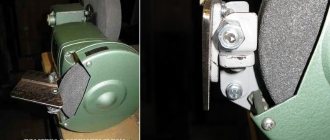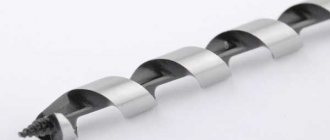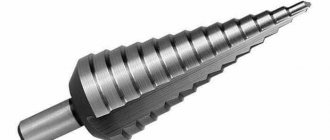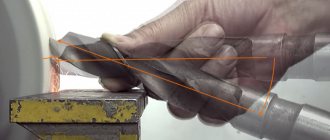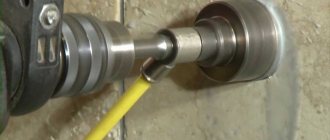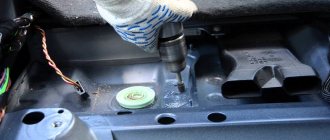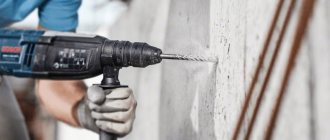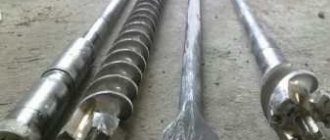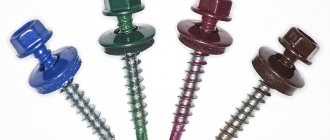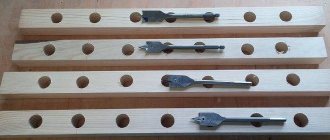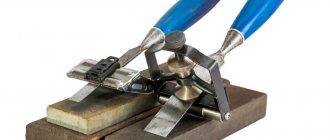Various manipulations with metal products, including drilling, are carried out not only in production, but also in domestic conditions. Tools for working with metal are initially made from materials with increased wear resistance, but over time, even such specialized products require one or another adjustment. In this regard, a fairly large number of questions arise, among which some of the most pressing are: how to sharpen drills for metal, how to sharpen drills for metal correctly and at what angle it is better to sharpen drills for metal.
Sharpening this type of drill must be carried out in compliance with all technological rules. Otherwise, even the highest quality instrument can be irrevocably damaged. We will tell you in detail about how to properly sharpen a drill for metal in our article.
SIGNS OF A DULL DRILL FOR METAL
- Increased noise emissions;
- Significant sudden heating of the working part and body;
- Unevenness and “raggedness” of the edges of the hole being developed;
- The need to increase physical effort;
- Changing the state of the chips from spiral-shaped to crumbling and small-sized;
- Increasing the surface temperature of the product;
- The appearance of previously uncharacteristic grinding and crackling noises during operation.
Sharpening at home
When sharpening drills with your own hands, the user is advised to adhere to safety rules. When working on sanding wheels, safety glasses must be worn. This will protect your eyes from abrasives and pieces of scale. Glasses must be used even if there is a protective screen on the sandpaper.
It is strictly forbidden to carry out work wearing gloves. The drill may get caught in the thread, causing hand injury. It is recommended to carry out work in tight-fitting clothing, the buttons of which are pre-fastened. It is recommended to adjust the support so that the gap between it and the stone is small.
Sharpening drills can be carried out in various ways, which allows a person to choose the most suitable option for himself. To avoid injury, you must adhere to safety precautions during work.
ANATOMY OF A DRILL
- Apex corner. It is located in the middle of the cutting edges and is the tip of the drill. The indicators of this angle vary depending on what kind of metal is to be drilled. The most universal angle is considered to be 118 degrees. It is suitable when working with soft materials, including soft metal. For dense and durable metals, the angle is over 135 degrees.
- Posterior peaks. They pass behind the cutting edges, bending and forming a clearance ranging from 8 to 15 degrees for universal options.
- Jumper. Essentially, it is an isthmus connecting two cutting parts. The main function of the jumper is to center the drill as it enters the metal.
- Spiral ribbons. Necessary to reduce friction, act as a heat sink and guide.
- Spiral hollows. They are discharge channels for the waste contents of the drilled hole.
- Shank. The connection point between the drill and the drill.
Spiral and back angles can be considered as separate parameters:
- The helix angle is a variable value and varies depending on what type of metal the drill is selected for. Large angle turns are suitable for softer metals that produce long chips. Low-angle spirals are suitable when working with hard metals and small chips;
- Back corner. Its dimensions vary from 7 to 17 degrees and depend on what metal is to be drilled.
Time to sharpen?..
It is difficult for an inexperienced craftsman to distinguish a well-sharpened tool from one that has already become dull. The main signs that it’s time to start sharpening are as follows:
- the metal gets very hot. Due to the fact that the cutting edge is worked, the friction during drilling increases. Accordingly, the working part and then the shank and the drill chuck (perforator) are heated. When strongly heated, the metal of the drill loses its properties, “relaxes” and ceases to hold an edge at all;
- the sound during drilling intensifies, creaking and squealing occurs;
- the chips come out either from only one side (uneven sharpening), or from both, but in the form of crumbs rather than a neat spiral.
Individually, these signs can be considered the result of working with too hard and brittle material, or an unsuitable type of drill in general. All together it clearly communicates – it’s time to sharpen the edges!
MAIN TYPES OF DRILLS AND FEATURES OF THEIR SHARPENING
- Single-plane. This type of drill has one plane on the rear feather wall. The plane inclination angle is 28-30 degrees. One working plane must be sharpened. The drill is held parallel to the rear plane in relation to the sharpening fixture.
- Two-plane. The only difference from single-plane ones is the presence of an additional plane.
- Conical drills. The main nuance of sharpening is the need to maintain a clear cone. Sharpening is carried out by oscillatory movements without detachment from the sharpening device.
Methods
When drilling into hard materials, only the edges should come into contact with them. That is why the back surface is sharpened at a certain angle. As a result of this operation, a gap appears between the edge and the bottom of the hole.
Sharpening is carried out using conical, two-plane or cone methods.
Using a conical sharpener
The drill is inserted into a special prism of the sharpening machine, which moves around its axis. The prism is positioned at a certain angle in relation to the grinding wheel. The back of the drill is shaped like a cone. It is located in the place where the working surface of the grinding wheel intersects with the swing axis.
In order to properly sharpen the drill, you need to first configure the parameters. The axis of the sharpening cone should be located at an angle of 45 degrees relative to the axis of the drill itself. Cone sharpening can be performed using two methods:
- The top of the cone that will be sharpened should be located below the top of the sharpening cone. It is first recommended to carry out the adjustment in accordance with the specified parameters: a - 45 degrees, b - from 13 to 15 degrees, n - 1.9d. the drill axis and the cone must intersect at an angle that is less than the angle of the grinding wheel and drill. If we sharpen using this method, we need to make sure that the tip of the drill is located above the top of the sharpening cone. The tip and the drill should be 1.06 in apart. The axis of the drill and the axis of the cone should intersect at an angle of 90 degrees.
- In order to ensure the rear angle for the peripheral point, it is necessary to provide indicators - a-5-7 degrees, angle 2f - from 116 to 118 degrees. the cutting transverse edge should be at an angle of 55 degrees.
The use of the conical method is recommended to create a sharper increase in the back angle of the drill. This method can be used if the drill has a large diameter - more than 3 millimeters.
Using screw sharpening
If there is a need to automate the process of sharpening drills, then the use of the screw method is recommended. It lies in the fact that translational movements are coordinated with the rotations of the grinding wheel. With its help, you can simultaneously sharpen the front and rear corners.
When screw sharpening, the rear angles of the working part increase as they approach the center. When using this method, there is a decrease in the strength of the transverse edge of the drills, which leads to their breakage when drilling excessively hard materials.
Two-plane sharpening
Using this method, it is recommended to sharpen drills that are intended for drilling non-hard materials. If the diameter of the drill is less than 3 mm, then the use of this sharpening method is recommended. Using this method, drills are sharpened at an angle of 60 degrees. Thanks to this method, products are improved rather than errors are corrected.
HOW TO CORRECTLY SHARPEN A DRILL FOR METAL: DETAILED INSTRUCTIONS
- Rotations of the abrasive element are made in the opposite direction relative to the plane being sharpened.
- It is important to maintain the correct angle without allowing displacement. Choosing at what angle to sharpen metal drills is the most important part of the entire process.
It is worth considering that for each metal, the angle has its own parameters:
- Cast iron and steel. For these metals, an angle in the range of 116-118 degrees is considered optimal;
- Brass and bronze. The sharpening angle should correspond to 120-130 degrees;
- Copper. The maintained angle has clear boundaries and is equal to 125 degrees;
- Aluminum. This metal, like copper, requires a maintained angle of 140 degrees.
Maintaining the correct angle is the main requirement, violation of which during the process of sharpening a drill for metal can lead to damage to the product.
- Restorative manipulations when processing edges are carried out in one working approach.
- The heated part of the shank must be cooled at the moment of changing position.
- When working with single-plane drills with a diameter of no more than 3 mm, a parallel position of the cutting edge and the plane of the grinding wheel is ensured. The clamping is carried out while maintaining the rear angle of 26-30 degrees.
- When working with conical products larger than 4 mm in diameter, it is important to make smooth movements that maintain the tapered shape. It is strictly forbidden to stop contact between the surface of the drill being sharpened and the sharpening surface. All turns are carried out smoothly, in the shape of a cone and in one touch. The new cycle starts from the working edge and proceeds through a complete rotation, maintaining the required angles.
- A necessary condition is to maintain the rake angle located between the working part of the tool and the base of the cutting edge. The measurement is made with a special device in the main plane.
- It is also important to pay attention to the angle located in the rear plane.
- The angle of the cutting edges should be at the apex between the edges.
Angle measurements are made with templates that have special cutouts, or with a Slepnin device.
In addition to maintaining the correct angles, an important aspect in the question “ how to properly sharpen a drill for metal ” is maintaining the correctness of the edge itself. This point is especially relevant for drills with large diameters exceeding 10 mm. In addition to the surfaces that must be sharpened, for drills with a large diameter, the front surface is subject to sharpening. This need is due to the fact that reducing the angle of inclination of the front plane leads to an expansion of the angle of the cutting edge and a decrease in the length of the transverse edge. Due to such changes in parameters, the drill does not cut through the metal, but scrapes it out, forming irregularities and defects.
Useful tips
We can talk a lot about the nuances of sharpening, but it is important not only to sharpen the tool correctly, but also to do it safely and then store the products correctly.
So, the rules for the safety and maintenance of drills:
- When sharpening, the tool gets very hot. This not only requires careful handling and – very desirable – wearing protective gloves. This also affects the properties of the metal. Therefore, the tool should be fed to the sharpening device in short periods, 2...3 seconds, and cooled after each period in water or other cutting fluid (cutting fluid);
- During work, sparks fly from the drill and grinding wheel. You need to protect not only your hands, but also your face. A transparent shield or glasses will be very useful;
- For delicate work you need to see very well what exactly is being done. Accordingly, a magnifying glass may well play the role of a protective shield;
- Additional lighting is necessary, but the lamp must be positioned so that the fragile bulb cannot be damaged by random fragments of metal or abrasive.
Regarding storage, the rules are simple: sharpened drills should not touch each other and should not be in a damp or aggressive environment. Special organizers – industrial or homemade – are very convenient for permanent storage. If there are inscriptions about the diameter, the search for the desired tool occurs almost instantly.
EQUIPMENT FOR SHARPENING DRILLS FOR METAL
The process of properly sharpening a drill for metal begins with selecting the necessary equipment:
- Grinding machine.
- Sharpening or emery machine.
- Electric drill.
- File.
Auxiliary means.
- Set of grinding wheels. It is selected depending on the material from which the drill is made.
Determining drill material type:- High speed steel. This type of drill is designated HSS. Such drills are made of alloy carbon steel and have the addition of tungsten, chromium and molybdenum. High-speed drills are used for work at high speeds;
Cobalt steel. Such drills are marked CO (cobalt) and a designation indicating the percentage of cobalt. It should be borne in mind that although cobalt drills are capable of maintaining their sharpness for a long time even at high loads and temperatures, they are brittle compared to high-speed steel. Sharpening such drills requires the greatest care;
- Tungsten carbide drills. They have extremely high rigidity and significant fragility.
- Container with water. For cooling, ordinary water is most often used. However, machine oil shows much better performance as a coolant.
- Fixing device.
- Goniometer.
- Personal protective equipment: glasses and gloves.
In addition to the material of manufacture, manufacturers indicate what kind of processing the drill undergoes and what coating it is protected with. All these nuances are important when selecting the tool needed for sharpening. In addition to the above, you need to know at what angle you need to sharpen drills for metal. To achieve the best possible result, it would be a good idea to focus on the anatomy of the drill.
For a more visual representation of the upcoming manipulations, it is necessary to take a closer look at the structure of the drill.
Tools for facilitating sharpening
Here we will no longer talk about machines, but about useful and convenient devices that simplify work and help maintain the correct angle.
These can be purchased products, for example, this conductor comes from AliExpress. The sharpening disk is very small; rotation is transmitted to it from a drill chuck connected using a special adapter. The user only needs to insert the drill into the groove and turn on the drill. An overview of the use of such a conductor is described in this video.
For those who do not respect Chinese products, there are these racks.
There is a dial on the bottom of the device that allows you to rotate the holder with the drill to the desired angle.
There are also a number of homemade conductor devices designed for convenient sharpening. For example, here are two of them.
There is also an original door hinge fixture.
HOW TO SHARPEN A DRILL FOR METAL
The process of sharpening drills is as follows:
Grinding machine (grinder)
The sharpening process is carried out in several stages.
- The drill is fixed in a vice maintaining the angle of inclination;
- An abrasive disc is installed on the machine, selected in accordance with the type of drill and its purpose;
- The switched on machine is brought to the drill.
An alternative way to work is a method where it is not the drill that is attached, but the grinder itself.
During work, it is necessary to observe personal protective measures, since there is a fairly high risk of the drill slipping off the sharpening surface.
Emery machine
This device is considered one of the most convenient and justified when working at home. One of the important conditions when working with an emery machine is the correct contact between the edge and the sharpening surface. The edge must be strictly parallel.
Electric drill
A drill is an alternative to a grinder and a sharpening machine. For sharpening manipulation, a sharpening wheel is installed on it. The essence of the actions is similar to working with a grinder and implies two options for fixation: the drill is fixed, or the drill itself is fixed.
The nuances of working with a drill:
- The tool is fixed in a vertical position;
- The trailing edge is processed with a grinding wheel to remove the effects of wear;
- Sharpening is carried out to achieve the required angle, which is most often 120 degrees.
Throughout the sharpening of the edge, which lasts on average about 2 seconds per session, control over the degree of heating is necessary. To simplify the process, you can purchase a special attachment that is installed directly on the drill and acts as a drill clamp and guide.
What you should pay attention to when sharpening a metal drill:
- Such attachments are only suitable when working with drills not exceeding 4-10mm in diameter;
- Drills with serious damage and significant wear cannot be sharpened using this method;
- It is not possible to select an individual angle when using the nozzle. In this regard, if we are not talking about standard angles, modification will be required to ensure that the necessary angular parameters are met.
File
Sharpening with a file or needle file is most often done when it comes to drills that cannot be sharpened by other means due to their small diameter of 4 mm or less. When processing thin drills, it is allowed to grind off a layer not exceeding 1 mm. The angles will have to be maintained in a standard turn. During the work, you will need good lighting and the presence of magnifying devices.
Do-it-yourself metal drill sharpening
The simplest and most convenient device for sharpening drills for metal can be made independently with your own hands.
This device consists of:
- Vala;
- Drill chuck;
- Protractor-protractor;
- Guide rollers.
The base, with a protractor attached to it, is made of any available material, which must be sufficiently strong and wide.
Sharpening machine and its modifications
So, the basic piece of equipment is a sharpening machine.
One of the simplest options is a grinder mounted on a base with a suitable grinding wheel.
Using a special holder, the power tool is fixed on a table or workbench so that when the chuck rotates there is no displacement and vibration is damped. Using such a device, you can not only sharpen a tool, but also grind parts. Depending on how convenient it is to work, the axis of rotation is directed horizontally or vertically.
The next option is a simple sharpening machine, for example, a Soviet-made IE-9703 (the so-called sharpener).
There is space here to install only one circle.
A more “advanced” version of the same type is the 3K634 roughening and sharpening machine and its analogues. For a home, such equipment is usually not needed; this is an industrial option. As a last resort - for an actively used workshop.
Among the more modern and compact universal products, I would like to name the following:
- ELITECH CT600C. Practical, you can sharpen anything - from drills to chains and axes. For working with small tools there is a magnifying glass and a lamp. There is a spark arrester and a fairly powerful drive;
- BISON ZTSHM-150/686L. The design is similar to the previous one, but simpler and cheaper;
- Energomash TS-6010S. A very convenient thing, with separate blocks for sharpening different tools, with the ability to rigidly fix the item being sharpened to obtain the desired sharpening angle.
Specialized machines for sharpening drills for metal (and not only) have a narrower functionality. They differ in the number of simultaneously sharpened tools, their minimum/maximum diameter and possible sharpening angle.
For example, the OPTIgrind GQ-D13 and OPTIgrind DG 20 Vario machines differ in angle, drill diameter, and size/power. What they have in common, perhaps, is only the number of simultaneously processed products - one at a time.
OPTIgrind GQ-D13 OPTIgrind DG 20 Vario
Machines with a grinding wheel and a special drill holder are convenient. By changing the position of the holder, you can adjust the sharpening angle. For such professional machines you can buy sets of collets for sharpening, additional templates and other useful devices that make your work much easier.
For home use, professional machines are still a little overkill. You can get by with simplified machines designed only for drills and not upsetting customers with exorbitant prices.
In addition, there are special drill attachments that allow you to sharpen drills relatively quickly and with good accuracy. The last parameter, of course, depends on the quality of the nozzle. Alas, such attachments usually have a fixed sharpening angle – most often the standard 118 degrees.
Both of the latter options work on the same principle - the drill is inserted with the working part down into the corresponding diameter hole on the nozzle and pressed. The device turns on, sharpening occurs.
HOW TO CORRECTLY SHARPEN A DRILL FOR METAL: CONCLUSION
Regardless of the tool used to sharpen the metal drill, it would be useful to carry out finishing manipulations. The most popular are silicon carbide stones marked 63c and a circle with a grain size of 5-6 and a hardness of m3-cm1. An alternative could be CBN with a grain size of 6-8. A bakelite bond is required for both options.
Compliance with all the listed nuances and rules will reduce the risk of damage to the drill to a minimum and will significantly simplify the upcoming work, while maintaining a fairly high quality. It is worth considering that the personal experience of the master and the quality of the devices used play an important role.
Signs that a tool is dull
First, let's explain why it is necessary to monitor the condition of the equipment. If it is poorly sharpened, then over time, due to constant mechanical and thermal effects, it can break directly during the metalworking process. Where it leads:
- to damage to the workpiece, because a piece of debris remains inside the hole, which is then difficult to remove;
- to damage to the hands or other unprotected part of the turner’s body if the fragments fly to the sides.
But here’s what continuing processing with a cutter that has already served its useful life can lead to:
- to a sharp decrease in work productivity - the same procedure will take several times longer, as a result the final effect will not be achieved, and the metalworking accuracy class will decrease;
- to increased overheating - during friction, both the workpiece and the cutter begin to heat up, and any metal has a temperature at which it deforms;
- to work “idle”, that is, rotational movements of the tool will not lead to anything - this can only be achieved in the case of final dullness, most often happens with short products;
- to jamming of the entire machine - it is difficult to remove the workpiece, sometimes it is simply impossible to pull the fragment out of the hole, since it begins to melt there - this outcome most often awaits long drills;
- Some metal is strongly hardened after burning (the friction reaction leads to a change in physical properties due to transformations in the internal crystal lattice) - it is then very difficult to process it with other tools; in fact, it undergoes a partial, local hardening process.
To prevent such unpleasant consequences, before each new drilling cycle it is necessary to inspect all equipment for suitability.
Regular checks and monitoring the condition of the sharpening angle at the tip of the drill will help to avoid such consequences. It is not necessary to conduct instrumental analysis to understand that the cutter has become unusable. Here are some signs you can use to determine “by eye” that it needs sharpening:
- a clearly visible shine of the sharpening edges has appeared - when rounded, the material shines, which makes its head more noticeable, it differs from the other parts (from the shank and the main cylinder);
- the appearance of a tarnished color on the cutting tool - it can become, for example, black and blue, this effect is obtained due to a strong change in temperature, you can notice a similar process with a metallic tint in the coming off metal shavings when cutting;
- heating during operation - of course, it will occur even with the sharpest drill, but during operation of the interceding one it will be several times more noticeable;
- an increase in effort when used for a similar procedure is especially important when drilling with a hand tool (electric drill), because the feed is carried out not by a mechanism, but directly by the person himself, that is, the master will simply put more pressure on the device;
- a creaking sound already indicates that sharpening will not help - such a cutter should simply be thrown away, it has been ground down to a faulty state;
- a rough assessment can be considered palpation with a finger; a round edge will be felt under the pad - the sharpness of the edge is very easy to determine, but a person who is little familiar with turning will not always draw the correct conclusion the first time;
- Various defects may appear on the cutting surface - chips, burrs, etc., despite the fact that previously everything was fine with the same components (machine, metal, drill, master);
- You can see the wear if you use a magnifying glass.
We'll give you advice on what to pay particular attention to. The very first thing in any drill that becomes unusable is the central part and the outer corner edges, because they experience the greatest thermal impact. After heating, the steel becomes softer and deforms more easily.
In addition, the wider the radius, the greater the cutting material, that is, the maximum load on them. The central part does not participate in the cutting function, but rather pushes the material apart.
So that the center does not experience heavy loads and does not wear out at an accelerated rate, it is recommended to drill a preparation hole (roughing) with a cutter of a smaller diameter, and then during the second pass, be sure to use soap emulsions for cooling or, in the most primitive version, water.
Features of drills and what the sharpening angle depends on
Of course, when choosing a cutting tool, a master must take into account many factors, because there are a large number of design options and standard sizes. Based on the features, not only the cutter is selected, but also the type of metalworking. Each process has its own special characteristics.
They depend on:
- The material you are working on. Some steels have increased hardness, others can be brittle, and others can be malleable and soft.
- The qualities of the drill itself - similar rules apply here.
- The turner’s task is what size, as well as the accuracy class, must be ensured.
Based on this and some other factors, the drilling mode is selected - when the optimal pressure and speed are selected, in other words, the feed and rotation speed of the tool. If we are talking about drilling with an electric drill, then such indicators are quite difficult to calculate.
But in the case of working with machines (drilling, turning), this indicator is very important. It is most convenient to work with CNC equipment, since the control panel automates many processes, including the calculation and setting of the above parameters.
You can buy devices for CNC milling and turning of metal on the company’s website https://stanokcnc.ru/.
At what angle to sharpen the drill also depends on what purpose the turner is pursuing, as well as what material he is working with. Let's give an example. If the workpiece being processed is made of a very hard alloy, and the cutter has an excessively sharp edge, then there is a high probability that it will simply break when pressed. There are two ways to get out of this situation:
- change the sharpening angle to a more blunt one;
- do preliminary roughing - drill a small hole in this place.
Recommendations
Conventional drills are sharpened with your own hands on a simple sharpener, a saw with a large grinding disc, an angle grinder or a drill with an attachment. But crown molding may require a special machine. The fact is that the crown has an axis - the main drill, which is a regular product. And if it is sharpened in a simple way, then the toothed, saw-like edge of the crown will require machine conditions. The same is true for cone-step drills.
In the worst case, due to the intoxication of the steel rusting in the salty environment, a person will easily lose it. Be careful not to drill into the ceiling without a helmet - falling chips will also get into your unprotected eyes.
Choose the correct point angle. A drill that is too “flat” will not drill through steel; a drill that is too “steep” will not drill through wood, aluminum, bronze, magnesium, or plastic. An incorrect angle will either cause the drill to wobble and the hole to move, or it will jam and break.
Do not drill with ordinary high-speed steel in glass, porcelain tiles, granite, ceramics, or high-strength clay. For these materials there is a so-called win. Pobedit alloy significantly exceeds high-speed steel in strength. Do not try to drill into tempered glass - it will immediately crumble.
Do not sharpen pobedit drills with simple sandpaper and stone-vitrified wheels - for these products there is a diamond, like those wheels that are used to cut stone, brick and hardened steel. Grind pobedit drills at low speeds.
Do not overheat the drill when turning - overheated steel will experience tempering and become noticeably worse. It will no longer be hardened or high-speed (tool-based).
Do not cool a red-hot turned drill in water or other cold liquids - sudden cooling will cause it to become riddled with microcracks. The first time you try to drill into a workpiece, the product will immediately break.
Do not deflect the drill while turning. The slightest care - even by a degree - will lead to uneven grinding, vibration will arise, breaking the drill itself and loosening the gearbox and motor of the drill.
The length of the working part should not be less than a centimeter. If the drill is broken in half and part of the cutting area is thrown away, then do not grind the drill, whose working part is now less than a centimeter.
Drills tipped with carbide (for example, with a pobedit tip, diamond coating) are sharpened using the same means as solid drills made from the same materials.
How to easily sharpen a drill, see below.
Where are cone drills used?
Cone drills are used for drilling holes of different diameters in thin sheet materials. Moreover, the resulting holes are distinguished by such advantages as evenness and accuracy without scoring, chips or burrs. You can drill through thin-sheet material with a regular cylindrical drill, but the quality of the work will suffer and the task will also become more complicated. For example, the slightest deviation of the drill from the surface will result in a triangular or oval hole rather than a round one. In addition, burrs, scuffs and chips are formed, which ultimately negatively affects the quality of the work performed.
The use of conical drills can significantly simplify the work, eliminating all the disadvantages of cylindrical devices. Due to its advantages, the equipment has found its application in various fields:
- Automotive and repair
- Landscape design
- Construction
- Installation of plumbing equipment
- Installation of electrical installations
The device is not effective in situations where you have to drill holes in materials whose thickness is more than 10 mm.
This is interesting!
When drilling sheet metal, it turns out that on one side the drilled hole has an ideal shape, and on the other it has burrs. It is very easy to correct the situation; to do this, you need to use the nozzle on the reverse side.
Sharpening quality control
To restore the original parameters of the tool, it is necessary to select a grinding wheel, the hardness of which allows you to qualitatively obtain the original parameters. At the initial stage, the rear surface is restored. The main task is the correct choice of feed angle to the surface of the grinding wheel. After completing this work, they begin to bring the leading edge to normal condition.
Failure to comply with these requirements will lead to deterioration in the quality of drilled holes and disruption of cutting technology. After the operation is completed, the quality of the obtained parameters is checked. If certain deviations from the requirements were made, the drill is adjusted to the required condition. In enterprises where drills are used to produce a large number of holes, finishing is mandatory.
After completing all technological operations to restore the tool, it is recommended to check its basic geometric parameters. To solve this problem, the following devices are used:
- manufactured templates;
- device developed by V.A. Slepnin.
In the first case, ready-made templates are used, which are made according to a pre-calculated method. Such templates can be purchased ready-made through a retail chain or made independently. Methods for their manufacture are given in specialized literature or on Internet portals.
The basis of the device developed by Slepnin is made up of two disks. They rotate relative to each other. Its main advantage is the variability of possible measurements. This versatility eliminates the need to create a large number of individual templates. Therefore, the time required to check multiple products is significantly reduced.
When checking each tool after completing the sharpening operation, it is necessary to check not only the obtained parameters, but also the equality of the lengths of the opposite cutting edges. If they differ in length, this will lead to an increase in the diameter of the resulting hole. Next, you need to check the change in the clearance angle of the cutting edge. It should gradually increase towards the center of the instrument.
